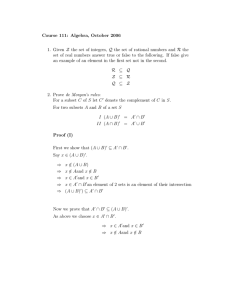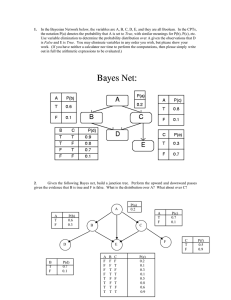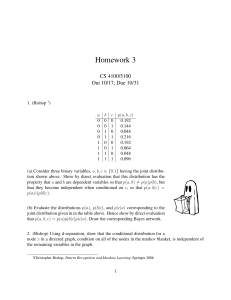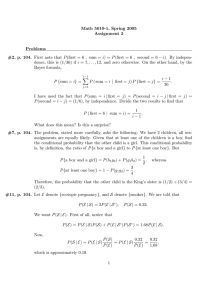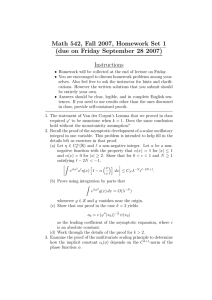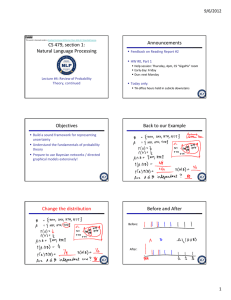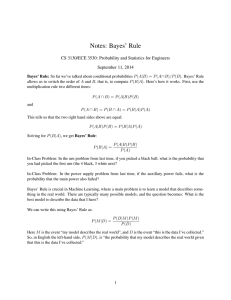Proof that the Bayes Decision Rule is Optimal
advertisement
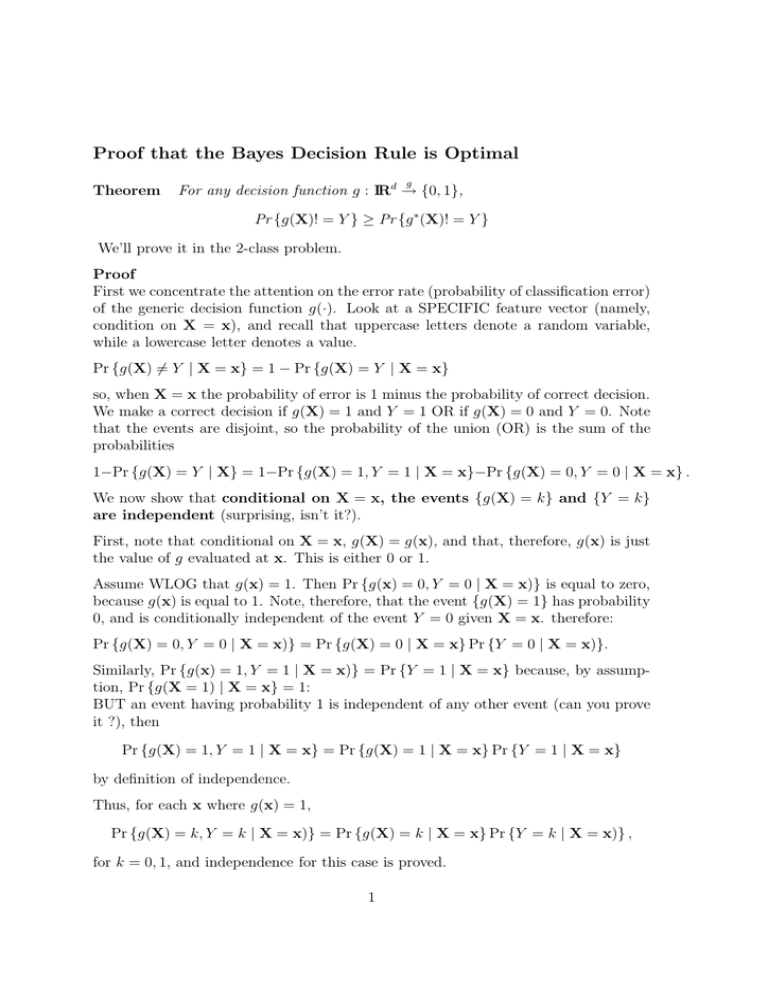
Proof that the Bayes Decision Rule is Optimal
Theorem
g
For any decision function g : IRd → {0, 1},
Pr {g(X)! = Y } ≥ Pr {g ∗ (X)! = Y }
We’ll prove it in the 2-class problem.
Proof
First we concentrate the attention on the error rate (probability of classification error)
of the generic decision function g(·). Look at a SPECIFIC feature vector (namely,
condition on X = x), and recall that uppercase letters denote a random variable,
while a lowercase letter denotes a value.
Pr {g(X) = Y | X = x} = 1 − Pr {g(X) = Y | X = x}
so, when X = x the probability of error is 1 minus the probability of correct decision.
We make a correct decision if g(X) = 1 and Y = 1 OR if g(X) = 0 and Y = 0. Note
that the events are disjoint, so the probability of the union (OR) is the sum of the
probabilities
1−Pr {g(X) = Y | X} = 1−Pr {g(X) = 1, Y = 1 | X = x}−Pr {g(X) = 0, Y = 0 | X = x} .
We now show that conditional on X = x, the events {g(X) = k} and {Y = k}
are independent (surprising, isn’t it?).
First, note that conditional on X = x, g(X) = g(x), and that, therefore, g(x) is just
the value of g evaluated at x. This is either 0 or 1.
Assume WLOG that g(x) = 1. Then Pr {g(x) = 0, Y = 0 | X = x)} is equal to zero,
because g(x) is equal to 1. Note, therefore, that the event {g(X) = 1} has probability
0, and is conditionally independent of the event Y = 0 given X = x. therefore:
Pr {g(X) = 0, Y = 0 | X = x)} = Pr {g(X) = 0 | X = x} Pr {Y = 0 | X = x)}.
Similarly, Pr {g(x) = 1, Y = 1 | X = x)} = Pr {Y = 1 | X = x} because, by assumption, Pr {g(X = 1) | X = x} = 1:
BUT an event having probability 1 is independent of any other event (can you prove
it ?), then
Pr {g(X) = 1, Y = 1 | X = x} = Pr {g(X) = 1 | X = x} Pr {Y = 1 | X = x}
by definition of independence.
Thus, for each x where g(x) = 1,
Pr {g(X) = k, Y = k | X = x)} = Pr {g(X) = k | X = x} Pr {Y = k | X = x)} ,
for k = 0, 1, and independence for this case is proved.
1
The same argument applies for each x where g(x) = 0: thus we can always write
Pr {g(X) = k, Y = k | X = x)} = Pr {g(X) = k | X = x} Pr {Y = k | X = x)} ,
for k = 0, 1, which concludes the independence proof.
Now note that Pr {g(X) = k | X = x} = 1 if g(x) = k, and = 0 if g(x) = k. By using
the notation 1A to denote the the indicator of the set A, we can write:
1−Pr {g(X) = Y | X} = 1− 1g(x)=1 Pr {Y = 1 | X = x} + 1g(x)=0 Pr {Y = 0 | X = x} ,
Let’s now subtract Pr {g(X) = Y | X = x} from Pr {g ∗ (X) = Y | X = x}:
Pr {g ∗(X) = Y | X = x} − Pr {g(X) = Y | X = x}
= Pr {Y = 1 | X = x} 1g∗ (x)=1 − 1g(x)=1
+ Pr {Y = 0 | X = x} 1g∗ (x)=0 − 1g(x)=0
(simple algebra). Noting that Pr {Y = 0 | X = x} = 1 − Pr {Y = 1 | X = x}, we can
then write
Pr {g ∗ (X) = Y | X = x} − Pr {g(X) = Y | X = x}
= Pr {Y = 1 | X = x} 1g∗ (X)=1 − 1g(X)=1
+ (1 − Pr {Y = 1 | X = x}) 1g∗ (x)=0 − 1g(x)=0
(1)
Now, note that 1g∗ (X)=0 = 1 − 1g∗ (X)=1 , etc. Hence,
Pr {g ∗ (X) = Y | X = x} − Pr {g(X) = Y | X = x}
= Pr {Y = 1 | X = x} 1g∗ (x)=1 − 1g(x)=1
+ (1 − Pr {Y = 1 | X = x}) 1 − 1g∗ (x)=1 − 1 + 1g(x)=1
=
(2Pr {Y = 1 | X = x} − 1) 1g∗ (x)=1 − 1g(x)=1
(2)
Now, note that, for each x,
• if Pr {Y = 1 | X = x} > 1/2, then by definition of the Bayes Decision Rule,
1g∗ (x)=1 = 1, and, in general 1g(x)=1 ≤ 1; thus, Eq 2 ≥ 0.
• if Pr {Y = 1 | X = x} < 1/2, then again by definition the Bayes Decision Rule,
1g∗ (x)=1 = 0, and, in general 1g(x)=1 ≥ 0; thus, Eq 2 ≥ 0.
This is true for X = x; Now, take the expectation with respect to f (X).
2



